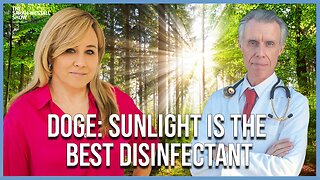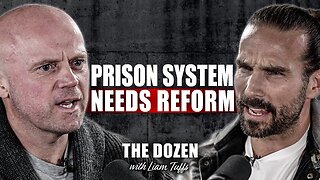Premium Only Content

CLIMATE SCIENCE 2 - There is No 'Extra Warming' to Explain
This the second in my Climate Science series debunking the greenhouse effect.
Climate Science 1 revealed that our atmosphere is not like a greenhouse; instead it's the exact opposite - it's capable of expansion and convection.
Here we explore the science and the climate cycles which the IPCC forgot to mention, and how they are totally controlling all current climate change.
We find that there actually is no 'extra' warming that we need to invoke a supposed 'greenhouse effect' from CO2 or other 'greenhouse gases' to fill.
Correction to CO2 forcing at 9:42 it is 0.01W/m2 not 0.1W/m2.
References;
Shaviv, N. J. (2003). The spiral structure of the Milky Way, cosmic rays, and ice age epochs on Earth. New Astronomy, 8(1), 39-77.
Cederlöf, M. (2014). Using seasonal variations to estimate earth's response to radiative forcing.
Shaviv, N. J. (2003). The spiral structure of the Milky Way, cosmic rays, and ice age epochs on Earth. New Astronomy, 8(1), 39-77.
65 million years of climate change (WIKI Commons)
5 million years of climate change (WIKI Commons)
Loehle, C. (2007). A 2000-year global temperature reconstruction based on non-treering proxies. Energy & Environment, 18(7), 1049-1058.
Usoskin, I. G., Solanki, S., & Kovaltsov, G. (2007). Grand minima and maxima of solar activity: new observational constraints. Astronomy & Astrophysics, 471(1), 301-309.
Steinhilber, F., Abreu, J. A., Beer, J., Brunner, I., Christl, M., Fischer, H., . . . McCracken, K. G. (2012). 9,400 years of cosmic radiation and solar activity from ice cores and tree rings. Proceedings of the National Academy of Sciences, 109(16), 5967-5971.
Lüdecke, H.-J. (2011). Long-term instrumental and reconstructed temperature records contradict anthropogenic global warming. Energy & Environment, 22(6), 723-745.
C-14 record from the USGA
Lüdecke, H.-J., Hempelmann, A., & Weiss, C. (2013). Multi-periodic climate dynamics: spectral analysis of long-term instrumental and proxy temperature records. Climate of the Past, 9(1), 447-452.
Sromovsky, L., Fry, P., Limaye, S., & Baines, K. (2003). The nature of Neptune’s increasing brightness: Evidence for a seasonal response. Icarus, 163(1), 256-261.
Schmude Jr, R. W., Baker, R. E., Fox, J., Krobusek, B. A., Pavlov, H., & Mallama, A. (2016). The secular and rotational brightness variations of Neptune. arXiv preprint arXiv:1604.00518.
How to support me, and of course evidence-based science;
Patreon support;
https://www.patreon.com/1000Frolly
To cite my published climate papers;
Holmes, R. I. (2018). Thermal Enhancement on Planetary Bodies and the Relevance of the Molar Mass Version of the Ideal Gas Law to the Null Hypothesis of Climate Change. Earth, 7(3), 107-123.
Robert Ian Holmes, On the Apparent Relationship Between Total Solar Irradiance and the Atmospheric Temperature at 1 Bar on Three Terrestrial-type Bodies, Earth Sciences. Vol. 8, No. 6, 2019, pp. 346-351. doi: 10.11648/j.earth.20190806.15
Holmes, R. I. (2017). Molar Mass Version of the Ideal Gas Law Points to a Very Low Climate Sensitivity. Earth Sciences, 6(6), 157.
Links to my published climate papers;
https://www.researchgate.net/publicat...
https://www.researchgate.net/publicat...
https://www.researchgate.net/publicat...
-
 2:41:13
2:41:13
vivafrei
12 hours agoEp. 251: Bogus Social Security Payments? DOGE Lawsduit W's! Maddow Defamation! & MORE! Viva & Barnes
187K227 -
 1:19:23
1:19:23
Josh Pate's College Football Show
5 hours ago $1.70 earnedBig Ten Program Rankings | What Is College Football? | Clemson Rage| Stadiums I Haven’t Experienced
42.6K -
 LIVE
LIVE
Vigilant News Network
10 hours agoBombshell Study Reveals Where the COVID Vaccine Deaths Are Hiding | Media Blackout
1,923 watching -
 1:17:59
1:17:59
Sarah Westall
6 hours agoDOGE: Crime & Hysteria bringing the Critics & the Fearful - Plus new CDC/Ukraine Crime w/ Dr Fleming
26.4K3 -
 45:39
45:39
Survive History
12 hours ago $3.33 earnedCould You Survive in the Shield Wall at the Battle of Hastings?
26.6K5 -
 1:50:28
1:50:28
TheDozenPodcast
10 hours agoViolence, Abuse, Jail, Reform: Michael Maisey
71.4K2 -
 23:01
23:01
Mrgunsngear
1 day ago $4.23 earnedWolfpack Armory AW15 MK5 AR-15 Review 🇺🇸
64.9K12 -
 25:59
25:59
TampaAerialMedia
1 day ago $2.01 earnedUpdate ANNA MARIA ISLAND 2025
38.3K3 -
 59:31
59:31
Squaring The Circle, A Randall Carlson Podcast
12 hours ago#039: How Politics & War, Art & Science Shape Our World; A Cultural Commentary From Randall Carlson
29.9K2 -
 13:21
13:21
Misha Petrov
12 hours agoThe CRINGIEST Thing I Have Ever Seen…
23.8K48